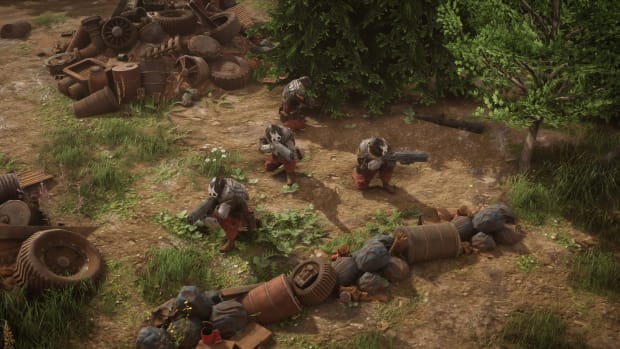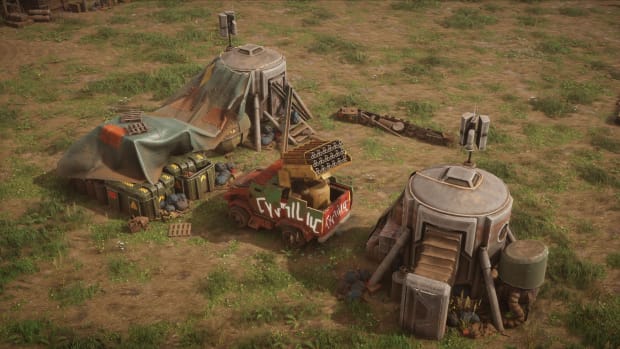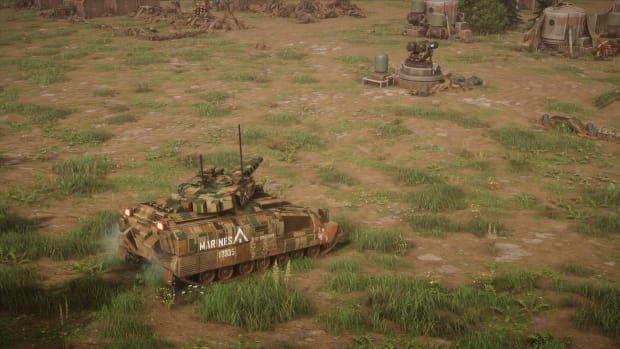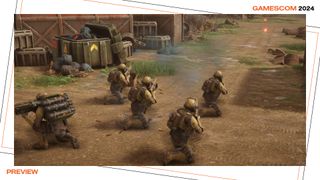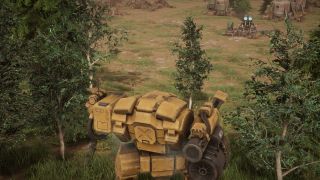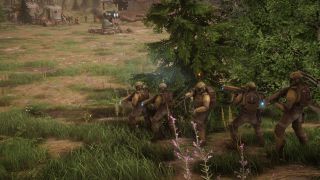It’s been quiet around the turn-based tactical RPG from Battle Brothers developer Overhype Studios for a while now, but rest assured: The team spent all this time wisely and
Menace is shaping up to be a real treat for genre fans. After chatting to the founders of Overhype about
Menace’s Battle Brothers DNA last year at Gamescom, I had the opportunity to sit down with them at this year’s trade fair once more to see the project’s progress firsthand.
I’d urge you to read last year’s piece for a more thorough overview of what Menace is, but to quickly sum it up: It’s a spiritual successor to Battle Brothers, a mercenary sim set in a sci-fi universe that will have you build up a strong military force and interact with different factions present in the solar system you’ve arrived in – but aside from fellow humans, a much darker threat looms on the horizon. Menace combines crisp, turn-based tactical combat with some strategic decision-making and character management on the sector map.
Brothers Paul and Jan Taaks of Overhype tell me that since last year there has been progress in pretty much every area of the game, and the small team has begun working on the final UI recently with the help of a freelance artist who comes with fantastic space game credentials – work on Stellaris, among other titles.
Concepts for the sector map show different types of planets – and in Star Wars-fashion, each world is dedicated to one type of environment. “We had the idea to have multiple biomes on one planet, but it was mushing up their identity, so we went with the classic desert planet, ice planet, and so on,” the Taaks explain. “It doesn’t make any sense, but it’s very good for each planet’s identity, so that you know which world you’re currently on.”
That doesn’t mean monotony, though: There will still be different types of environments on these worlds. Deserts, for example, can be rocky or sandy and may have some vegetation as well – not to speak of potential oases that can serve as battlegrounds.
Even mechs can be sneaky, given the right cover. / Overhype Studios / Hooded Horse
As we touched on last year, each planet will be inhabited by a different faction – and friendship isn’t exactly the way of being in the Wayback System. Naturally, that’s good news for you: The distrust and hostility between everyone means that the mercenary business will be booming. However, you’ll need to be careful in selecting your missions: You’ll be pulled into the sector’s politics one way or another, so choose wisely who to make allies and enemies with.
Increasing your standing with a faction allows you to access their technology and equipment, in turn, influencing your playstyle for this campaign – it’s this element that will give different runs of Menace their unique flavor. You can’t get all the upgrades from all the factions, because of the simple reason that you can’t please everyone.
“On the star map we’ll have a bit of a role-playing element in the form of events. Factions leaders will contact you and sometimes ask you to do an operation for them or they’ll ask favors of you, such as smuggling a spy to a certain planet,” they describe. There will also be internal events for you to deal with as your ship’s commander. All of these happenings – and your reactions to them – will have consequences. Some of these are political, others affect your soldiers in the form of emotional states.
Your squad leaders can become disgruntled, overconfident, high-spirited, and so on as a result of your event choices, but also if what transpires during combat. The brothers show me a battle during which one of the squad leaders gets downed and her unit wiped out. The squad leaders don’t die immediately and can be stabilized inside a time limit, allowing you to keep them alive – if you don’t reach them in time, though, they are gone for good. In this case, the character made it through. However, because she was saved by a squad leader she doesn’t like, she gained the disgruntled state, while her savior – a former pirate – became overconfident. These emotional states have positive and negative effects, but most importantly they reflect your decisions, your journey, and the relationships between your characters – and that’s one of the big targets the brothers set themselves for Menace, as opposed to Battle Brothers’ shallower interactions.
You’ll also have access to a resource called Authority, which you can use to “buy your way out of events” sometimes, as the Taaks put it.
“It’s this Frostpunk-style decision-making,” they tell me. “It’s there to loosen up the game and tell some more stories between the tactical combats.”
Every faction in Menace has their own personality, behavior, and equipment. / Overhype Studios / Hooded Horse
Speaking of combat: As you may remember from last year, battles happen as part of operations, which essentially are self-contained military campaigns that will reward you for completing them. What’s special about Menace is that you need to fight an entire operation (so a series of battles) with the same persistent force you assemble specifically for it. That means you need to be as efficient as possible with your forces and avoid any losses, since you may run out of steam for the last stretch of the campaign otherwise.
Upgrading your ship with better sensors provides crucial information about what kind of forces you’ll face and where they are positioned before you embark your troops. This entire part of the game – from embarking your forces to the nitty-gritty details of the battle mechanics – is heavily inspired by tabletop wargames like Warhammer 40,000 and Star Wars: Legion.
Each soldier, vehicle, and piece of equipment you have in your arsenal is associated with a points cost and you’ll have a set pool of points for an operation, so you’re completely free in the way you customize your army for every campaign. Your squad leaders typically lead a handful of troops into battle or serve as pilots for tanks and mechs. Their armaments and armor are all up to you to decide from whatever you’ve gathered on your journey. Squads can also bring auxiliary equipment like combat drugs to reduce suppression, smoke grenades to obscure the line of sight, or single-use rocket launchers for some anti-armor capabilities.
Though the brothers think this concept is very important to the game, they make it clear that “nothing is sacred” when the game launches in Early Access and that the team is “ready to question everything” in case surprising drawbacks are discovered.
“I can still imagine that this is one of the concepts that might get canceled. I have a bit of a feeling that maybe it’s the wrong road we’re taking, but I think it works very well at the moment,” Paul Taak says.
The developers say that the points system gives them a lot of freedom since they can come up with the wildest ideas for items and simply put them into the game with appropriately high points costs.
Meet the dreaded space pick-up truck with a mounted rocket launcher battery. / Overhype Studios / Hooded Horse
“A big problem in Battle Brothers for us was that in the later game it was impossible to make light armor viable, because it was just worse,” they say. “With this system, there is still an incentive to make, say, a squad that just has a grenade launcher, because if they stay out of sight and don’t get shot, they don’t need armor, and you can save those points to invest into something else.”
Weapons themselves have stats that are as detailed as you’d find them in first-person shooters with values like damage drop-off over distance, armor penetration, and so on. “Some people are already speculating that the game will be more streamlined or dumbed down because we use 3D graphics now, but that’s not the case. I think it’s even more complex than Battle Brothers because you have a lot more viable equipment choices for your squads,” they explain.
What stands out about Menace, even in this stage of development, is the attention to detail. The game tracks the ammunition count of special weapons for your forces as well as the enemy, so there’s another element of attrition in play that will deplete a squad’s effectiveness over time.
Though you’ll likely play from a top-down view most of the time, you can closely zoom into the action and see that each soldier has their own idle animations. When you select a unit and then move your cursor into different directions to aim at enemies or place a movement order, those troops will actively turn and mimic the direction of your cursor. Troops will banter among each other or call out enemies in close proximity. The pirate faction’s troops get really whiny when the tide of battle turns against them. Sneaking units that haven’t been discovered will whisper to each other in hushed tones. The Hamburg-based developers went with the British studio that worked on games like The Witcher to record all the voice acting in their game, and that seems to have paid off – there is lots of personality in the unit barks.
Combat has a lot of depth to offer and features cover, morale, and suppression systems. Units that lose troops will begin to waver and may rout like in a Total War game, only to recover a bit later and rejoin the fight. Instead of showing hard hit chances like XCOM, Menace currently uses a color-coded system to show the expected effectiveness of an attack, which takes into account everything from hit chance to distance – however, this only accounts for damage. Even shots going wide will build up suppression on the enemy, which forces the unit to hunker down and may even stun it for a round. As long as you get a shot out (not a given, since guns can get jammed), there will be some sort of effect.
Vehicles have directional armor values and can suffer modular destruction. / Overhype Studios / Hooded Horse
Vehicles have damage tables, which get rolled when they hit certain health thresholds and determine which of their modules get destroyed – or other fun effects. There is a flamethrower truck in the game that may get leaky when damaged, leading it to spread burning napalm over the battlefield as it drives around. They also feature different armor values on different sides, not unlike games such as Company of Heroes.
Cover and line-of-sight are massive components of combat – in the battle I see, the player doesn’t scout ahead properly and puts their tank into a terrible position, as nearby enemies reveal themselves to be RPG-carrying infantry squads. Flanking maneuvers seem to be absolutely devastating with some infantry squads getting wiped out quickly if they make one wrong step.
A lot of the smaller buildings provide cover despite units behind them being able to be targeted. “This is something we spent a long time experimenting on,” the brothers say. Having the line of sight blocked even by small obstacles brought the game to a standstill, so now units can see – and shoot – through assets like small buildings. It’s another solution that feels very tabletop.
Though it’s complex and deep, Menace goes by the rule of common sense to keep things manageable. “Even though the game is super complex, you can still just use what you think makes sense, like a rocket launcher against a tank, a machine gun against infantry, and you can see the color of the targeting ray, and it’ll work out like you’d expect it to,” they break it down.
Menace will feature varied mission types from straightforward “destroy the enemy base” battles to escort and extraction missions.
Another key feature of the game is its use of alternating turns: You get a move, the enemy gets a move – order of action is crucial. “I think that’s one of the things people will have to get used to the most. It’s very different from basically turn-based games except maybe for chess,” Jan Taak explains. “This allows us to get around Overwatch [the XCOM ability, not the game] and also makes what would otherwise be a pretty static game more dynamic, because it feels much more action-oriented with the back and forth.”
“The main ability you have to have in the game is to decide which unit to move first – it’s the most crucial skill,” he emphasizes. They report that even the test scenario they showed off at Gamescom throughout the week had vastly different results based on the action order.
Winning a mission is not everything – the game will actually rate your performance in each battle and reward you with promotion points based on that result, so being efficient pays off in more than one way. These promotion points can be used to unlock new skills for your characters and are universal – there are no separate XP values for each squad leader: “It’s kind of like XP, but you decide who gets it.”
Every character has a unique skill tree to fill out, providing them with various playstyles – the Taaks are not big fans of locking characters into one specific role.
In general, Menace’s setting feels pretty grounded as far as sci-fi goes. All enemy factions will have their distinct traits – which even influence how the AI plays them in battle –, but they remain human at their core, just like your army. This is a deliberate choice to make the eventual impact of the titular alien menace, which comes into play at some point during a run, all the greater.
The Taaks show me some concept art for this antagonist faction and appropriately describe it as “‘80s body-horror” inspired by movies like The Thing. They envision them moving like old-school animatronics – in a spooky, unnatural manner.
“We start with very simple units, basically like zombies, but as the game goes on they will get bigger and more complex. There will be boss menace monsters as well, which will be very large and have lots of skills” they state. Unlike the human factions, the menace might have access to supernatural abilities like “force fields, teleportation, and regeneration.”
As a tabletop wargamer myself, Menace sounds like the greatest digital sandbox I could think of.
Overhype Studios and Hooded Horse were not ready to share any details regarding the Early Access launch of Menace on PC yet, but we’ll be sure to keep you posted as soon as anything emerges.


















